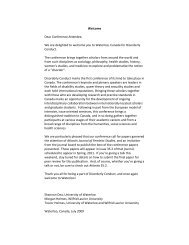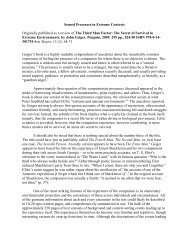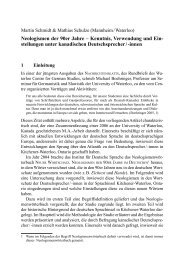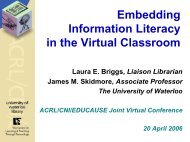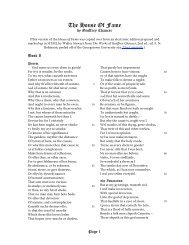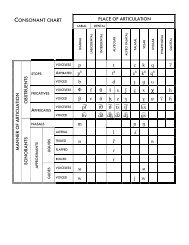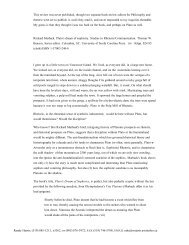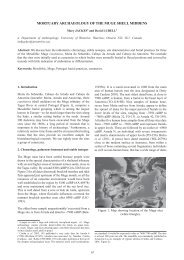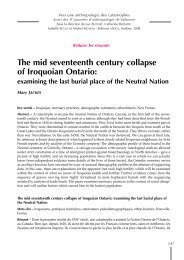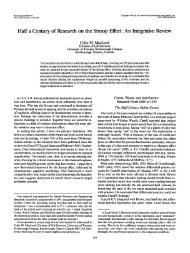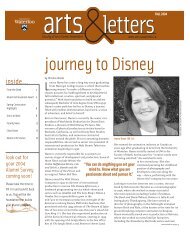Individual Differences in Learning and Memory: A Unitary ...
Individual Differences in Learning and Memory: A Unitary ...
Individual Differences in Learning and Memory: A Unitary ...
Create successful ePaper yourself
Turn your PDF publications into a flip-book with our unique Google optimized e-Paper software.
JOURNAL OF RESEARCH IN PERSONALITY 13, 530-545 (1979)<br />
<strong>Individual</strong> <strong>Differences</strong> <strong>in</strong> Learn<strong>in</strong>g <strong>and</strong> <strong>Memory</strong>: A <strong>Unitary</strong><br />
Information Process<strong>in</strong>g Approach<br />
COLIN M. MACLEOD<br />
Scarborough College, University of Toronto<br />
Recent research <strong>in</strong> the area of <strong>in</strong>dividual differences <strong>in</strong> learn<strong>in</strong>g <strong>and</strong> memory is<br />
reviewed from a cognitive perspective. Us<strong>in</strong>g the two-state model of memory as a<br />
framework, <strong>in</strong>dividual variations <strong>in</strong> attentional, short-term store, <strong>and</strong> long-term<br />
store processes are discussed. The focus is on us<strong>in</strong>g <strong>in</strong>dividual differences to<br />
evaluate nomothetic cognitive models, as well as on us<strong>in</strong>g cognitive models <strong>in</strong><br />
guid<strong>in</strong>g research on <strong>in</strong>dividual differences. Both with<strong>in</strong>-<strong>in</strong>dividual <strong>and</strong> between-<br />
<strong>in</strong>dividual differences <strong>in</strong> basic processes are exam<strong>in</strong>ed. In so do<strong>in</strong>g, the impor-<br />
tance of strategy choice is stressed us<strong>in</strong>g the concept of cognitive flexibility.<br />
Several promis<strong>in</strong>g directions, both methodologicat <strong>and</strong> theoretical, are noted <strong>and</strong><br />
the value of us<strong>in</strong>g specific <strong>in</strong>formation process<strong>in</strong>g models <strong>in</strong> the study of <strong>in</strong>dividual<br />
differences is emphasized.<br />
The study of how people differ <strong>in</strong> their abilities to learn <strong>and</strong> remember<br />
has a decidedly uneven history. Short periods of enthusiastic activity<br />
<strong>in</strong>evitably seem to lead to long periods of what might best be called<br />
“hibernation.” Furthermore, recurrent attempts to re<strong>in</strong>troduce the study<br />
of <strong>in</strong>dividual differences (e.g., Gag&, 1967; Jenk<strong>in</strong>s & Lykken, 1957;<br />
Sargent, 1942) seem to be heralded only by those already committed,<br />
ga<strong>in</strong><strong>in</strong>g few converts. We still cannot make very many firm statements<br />
based on our knowledge of <strong>in</strong>dividual differences. Nevertheless, the last<br />
decade has seen considerable activity with<strong>in</strong> this “second tradition” of<br />
scientific psychology, <strong>and</strong> the growth appears to be cont<strong>in</strong>u<strong>in</strong>g (see, for<br />
example, the recent reviews by Carroll & Maxwell, 1979; Eysenck, 1977).<br />
It is particularly encourag<strong>in</strong>g to see an emphasis on the role of <strong>in</strong>dividual<br />
differences <strong>in</strong> the development of theory (e.g., Underwood, 1973, for any<br />
theory is necessarily a statement of optimism with respect to its doma<strong>in</strong>.<br />
This issue of the journal presents the work of a number of different<br />
<strong>in</strong>vestigators <strong>in</strong>volved <strong>in</strong> study<strong>in</strong>g personality differences <strong>and</strong> their role <strong>in</strong><br />
Portions of this article were previously presented <strong>in</strong> a symposium entitled “Personality<br />
<strong>and</strong> <strong>Memory</strong>” at the 86th annual convention of the American Psychological Association <strong>in</strong><br />
Toronto, September 1978. Requests for repr<strong>in</strong>ts may be sent to Col<strong>in</strong> M. MacLeod, Division<br />
of Life Sciences, Scarborough College, University of Toronto, West Hill, Ontario MlC lA4,<br />
CANADA.<br />
0092-6566/79/040530-16$02.00/O<br />
Copyright @ 1979 by Academic Press, Inc.<br />
All rights of reproduction <strong>in</strong> any form reserved.
DIFFERENCES IN LEARNING AND MEMORY 531<br />
learn<strong>in</strong>g <strong>and</strong> memory. My purpose is to review the work <strong>in</strong> another area of<br />
<strong>in</strong>dividual differences, the cognitive approach to learn<strong>in</strong>g <strong>and</strong> memory.<br />
By necessity, this review will be highly selective, focus<strong>in</strong>g on a s<strong>in</strong>gle<br />
model <strong>and</strong> largely exclud<strong>in</strong>g the factor analytic evidence (but for an<br />
excellent review, see Carroll & Maxwell, 1979). Still, the hope is that it<br />
will help to reveal some of the parallels between the personality <strong>and</strong><br />
cognitive approaches, some of the discrepancies, <strong>and</strong> some of the issues<br />
be<strong>in</strong>g ignored by both camps.<br />
This article beg<strong>in</strong>s with a short <strong>in</strong>troduction to the prototypical <strong>in</strong>forma-<br />
tion process<strong>in</strong>g model of memory, the two-state model. In part, this<br />
approach is adopted to complement the review by Eysenck (1977), which<br />
takes a levels-of-process<strong>in</strong>g orientation (Craik & Lockhart, 1972). How-<br />
ever, I believe that the two-state model offers a better organizational<br />
scheme <strong>and</strong> does not have the predictive problems recently po<strong>in</strong>ted out by<br />
Nelson (1977) <strong>and</strong> Baddeley (1978). To reflect this concern, I have tried to<br />
suggest how one might phrase <strong>in</strong>dividual differences questions <strong>in</strong> terms of<br />
the two-state model. Us<strong>in</strong>g the component structures <strong>and</strong> processes of the<br />
model as an organizational framework, the next section of the article<br />
reviews an illustrative subset of the recent research <strong>in</strong> <strong>in</strong>dividual differ-<br />
ences. In this, the largest section of the article, I have attempted as much<br />
as possible to <strong>in</strong>tegrate the rather disparate f<strong>in</strong>d<strong>in</strong>gs. The f<strong>in</strong>al section<br />
provides an overview <strong>and</strong> po<strong>in</strong>ts to some of the emerg<strong>in</strong>g issues.<br />
THE INFORMATION PROCESSING MODEL<br />
The hallmark of cognitive approaches to the nomothetic study of learn-<br />
<strong>in</strong>g <strong>and</strong> memory is their reliance on box models such as the one shown <strong>in</strong><br />
Fig. 1. In this simplified version of the two-store model (cf. Atk<strong>in</strong>son &<br />
Shiffr<strong>in</strong>, 1%8), <strong>in</strong>puts enter the system through modality-specific sensory<br />
registers. These are brief “clear<strong>in</strong>g houses,” upon which attentional<br />
processes operate to select situation-relevant <strong>in</strong>formation. The hub of the<br />
system is the short-term store (STS), which can be likened to “conscious-<br />
ness.” Once selected <strong>in</strong>formation <strong>in</strong> the sensory register has been pattern<br />
recognized, it enters STS, the work<strong>in</strong>g memory (Baddeley & Hitch, 1974).<br />
Here a wide array of control processes, or strategies, can be called up<br />
from long-term store (LTS) <strong>and</strong> implemented. Among these are rehearsal<br />
schemes, encod<strong>in</strong>g <strong>and</strong> decod<strong>in</strong>g rout<strong>in</strong>es, <strong>and</strong> retrieval plans, to <strong>in</strong>dicate<br />
just a few. The goal state is LTS, the permanent storehouse of <strong>in</strong>forma-<br />
tion.<br />
There are only two major departures <strong>in</strong> Fig. 1 from the Atk<strong>in</strong>son <strong>and</strong><br />
Shiffr<strong>in</strong> (1968) model. First, there is a further subdivision of LTS <strong>in</strong>to a<br />
semantic <strong>and</strong> an episodic component. This is consistent with Tulv<strong>in</strong>g’s<br />
(1972) dist<strong>in</strong>ction between event-related <strong>in</strong>formation (episodic), <strong>and</strong><br />
event-free knowledge (semantic). Second, the pivotal “rehearsal buffer”<br />
<strong>in</strong> STS used <strong>in</strong> the orig<strong>in</strong>al model has been de-emphasized <strong>and</strong> now is
532 COLIN M. MACLEOD<br />
A%P *-------------------------, ,<br />
Pattern<br />
,<br />
Recognition I<br />
SHORT-TERM<br />
RESPONSE<br />
GENERATION<br />
FIG. 1. The prototypical two-state model of memory.<br />
<strong>in</strong>cluded as one of the available control processes. This change reflects<br />
the recent focus on process<strong>in</strong>g (as opposed to structural) variables <strong>in</strong><br />
learn<strong>in</strong>g <strong>and</strong> memory (cf. Craik & Lockhart, 1972).<br />
With this type of model <strong>in</strong> m<strong>in</strong>d, one can beg<strong>in</strong> to frame questions about<br />
<strong>in</strong>dividual differences <strong>in</strong> specific memory functions. A partial list of such<br />
questions might <strong>in</strong>clude:<br />
(1) Do people differ <strong>in</strong> the capacity of their sensory registers?’<br />
(2) Is attentionai allocation ability a source of <strong>in</strong>dividual differences? Does the<br />
speed of pattern recognition vary between <strong>in</strong>dividuals?<br />
(3) Can some people use STS more efficiently than others? Do some <strong>in</strong>dividuals<br />
have a larger set of available control processes?<br />
(4) What sorts of control processes should be used to accomplish optimal transfer,<br />
<strong>and</strong> do these differ from person to person?<br />
(5) Are <strong>in</strong>dividual differences <strong>in</strong> LTS primarily <strong>in</strong> the episodic or the semantic<br />
component? Does the efficiency of retrieval (<strong>and</strong> perhaps the utility of various<br />
cues) represent a dist<strong>in</strong>ct ability?<br />
Clearly, these are all possibilities <strong>and</strong>, with a little imag<strong>in</strong>ation, one can<br />
generate numerous other c<strong>and</strong>idates. Instead, let us look at some of the<br />
research this sort of model has generated, restrict<strong>in</strong>g discussion to post-<br />
perceptual process<strong>in</strong>g.<br />
1 Although I am omitt<strong>in</strong>g any discussion of <strong>in</strong>dividual differences <strong>in</strong> preattentional pro-<br />
cess<strong>in</strong>g, there is some evidence that this is an area worth pursu<strong>in</strong>g. For <strong>in</strong>stance, Snow<br />
(Note 12) discusses several studies of mask<strong>in</strong>g phenomena <strong>in</strong> iconic memory which clearly<br />
demonstrate <strong>in</strong>ter-subject differences.
Attention<br />
DIFFERENCES IN LEARNING AND MEMORY 533<br />
SOURCES OF INDIVIDUAL DIFFERENCES<br />
To beg<strong>in</strong> exam<strong>in</strong><strong>in</strong>g <strong>in</strong>dividual differences <strong>in</strong> attention, some sort of<br />
model is required. Kahneman (1973) <strong>and</strong> Norman <strong>and</strong> Bobrow (1975) have<br />
proposed rather similar systems based on the core notion of a s<strong>in</strong>gle pool<br />
of attentional resources available for the <strong>in</strong>dividual to allocate. This class<br />
of models offers some rather straightforward possibilities for an <strong>in</strong>dividual<br />
differences analysis. For example, <strong>in</strong>dividuals might differ <strong>in</strong> how effec-<br />
tive they are at mobiliz<strong>in</strong>g these resources when attention must be<br />
switched from one <strong>in</strong>put to another. Gopher <strong>and</strong> Kahneman (1971) pre-<br />
sent evidence <strong>in</strong> support of this prediction-the ability to switch attention<br />
from one ear to the other is an orderly function of the proficiency of<br />
military pilots. The same sort of pattern emerged <strong>in</strong> a later study us<strong>in</strong>g bus<br />
drivers’ safety records as the criterion variable (Kahneman, Ben-Ishai, &<br />
Lotan, 1973). Interest<strong>in</strong>gly, driv<strong>in</strong>g ability is a rather poor predictor of<br />
errors <strong>in</strong>focused attention <strong>in</strong> these same studies. Apparently, safe drivers<br />
make fewer errors when switch<strong>in</strong>g attention, but are not superior other-<br />
wise! This suggests that a study of <strong>in</strong>dividual differences <strong>in</strong> decision<br />
mak<strong>in</strong>g might have been quite reveal<strong>in</strong>g.<br />
More recently, Lansman (Note 7) has approached the exam<strong>in</strong>ation of<br />
<strong>in</strong>dividual differences <strong>in</strong> attention <strong>and</strong> memory from a different perspec-<br />
tive. Her hypothesis was that attention might play a central role <strong>in</strong> a<br />
person’s ability to ma<strong>in</strong>ta<strong>in</strong> a memory load <strong>and</strong> perform another task<br />
simultaneously, a situation we f<strong>in</strong>d ourselves <strong>in</strong> all too often. She tested<br />
this hypothesis with a secondary task methodology, us<strong>in</strong>g verbal ability as<br />
the critical <strong>in</strong>dividual differences variable. Although a subject’s digit span<br />
predicted how many items could be held <strong>in</strong> STS without attention (i.e.,<br />
while perform<strong>in</strong>g a second, attention-dem<strong>and</strong><strong>in</strong>g task), overall verbal<br />
ability was not predictive. Furthermore, verbal ability failed to predict<br />
rehearsal efficiency <strong>in</strong> STS, as measured by how much spare attentional<br />
capacity a subject had available to respond to an extraneous probe while<br />
perform<strong>in</strong>g a memory task.<br />
If one views Lansman’s tasks as more <strong>in</strong> the “focused” attention<br />
tradition, then her results can be seen as consistent with those of Kahne-<br />
man et al. (1973) <strong>and</strong> Gopher <strong>and</strong> Kahneman (1971). However, respond<strong>in</strong>g<br />
to a probe apart from the memory task does appear to be an attention-<br />
switch<strong>in</strong>g situation. Perhaps the <strong>in</strong>consistency between the two sets of<br />
studies stems from the dissimilarity of the variables chosen to def<strong>in</strong>e the<br />
<strong>in</strong>ter-subject differences. Whatever the reason, it still appears that the<br />
role attention plays <strong>in</strong> the memory system can be studied from the per-<br />
spective of <strong>in</strong>dividual differences. In fact, given the problems <strong>in</strong> theoriz-<br />
<strong>in</strong>g about attention, <strong>in</strong>dividual differences studies may provide fertile
534 COLIN M. MACLEOD<br />
ground for test<strong>in</strong>g nomothetic theories. Underwood (1975) already has<br />
<strong>in</strong>dicated the importance of this enterprise to theory <strong>in</strong> general.<br />
Short-Term Store Capacity<br />
Perhaps the most pervasive feature of any <strong>in</strong>dividual differences ap-<br />
proach to memory, be it factor analytic (e.g., Kelley, 1964), cl<strong>in</strong>ical (e.g.,<br />
Erickson & Scott, 1977), or experimental (e.g., Underwood, Boruch, &<br />
Malmi, Note 13), is the emphasis on a memory span construct. In terms of<br />
the model, this is a direct attack on the capacity of STS. Span ditfer-<br />
entiates the extremes <strong>in</strong> STS capacity well, as studies of retardates (e.g.,<br />
Chi, 1976) <strong>and</strong> mnemonists (e.g., Hunt & Love, 1972) clearly demon-<br />
strate. Although span may be less useful <strong>in</strong> discrim<strong>in</strong>at<strong>in</strong>g capacity differ-<br />
ences with<strong>in</strong> the normal range of abilities (cf. Hunt, 1978; Matarazzo,<br />
1972), it has had some success here as well. Furthermore, look<strong>in</strong>g at<br />
several studies together, an <strong>in</strong>terest<strong>in</strong>g pattern has emerged over the last<br />
couple of years.<br />
A popular hypothesis to account for <strong>in</strong>dividual differences <strong>in</strong> span relies<br />
on the notion that mnemonic strategies play a central role (e.g., Belmont<br />
& Butterfield, 1971; Ellis, 1970). Thus, rehearsal <strong>and</strong> chunk<strong>in</strong>g strategies<br />
should be crucial, as should temporal characteristics of the <strong>in</strong>put. Appeal-<br />
<strong>in</strong>g as this argument may be, it is almost certa<strong>in</strong>ly wrong. Studies of adults<br />
(Lyon, 1977) <strong>and</strong> children (Huttenlocher & Burke, 1976) have been fairly<br />
conclusive on this po<strong>in</strong>t. Why these differences exist is still an open<br />
question, but these studies show that the <strong>in</strong>dividual differences route<br />
could help clarify general theoretical concerns with the capacity of STS.<br />
In the context of the present model, this is a crucial direction to pursue.<br />
Short-Term Store Search<br />
The two-state model of memory h<strong>in</strong>ges on the STS construct. For this<br />
reason, much of the research effort has been directed at def<strong>in</strong><strong>in</strong>g the<br />
characteristics of STS. One of the most studied characteristics is the<br />
scann<strong>in</strong>g of STS for target <strong>in</strong>formation, based on the paradigm <strong>in</strong>troduced<br />
by Sternberg (1966, 1975). The picture that emerges from memory scan<br />
with respect to <strong>in</strong>dividual differences is very rem<strong>in</strong>iscent of the picture<br />
observed with memory span-at the extremes, scann<strong>in</strong>g times seem to be<br />
affected, but the pattern disappears <strong>in</strong> the normal range (cf. Hunt, 1978).<br />
Harris <strong>and</strong> Fleer (1974) observed markedly slowed scann<strong>in</strong>g <strong>in</strong> retard-<br />
ates <strong>and</strong> Hunt <strong>and</strong> Love (1972) observed very rapid scann<strong>in</strong>g <strong>in</strong> their<br />
mnemonist subject. However, for college students vary<strong>in</strong>g <strong>in</strong> verbal abil-<br />
ity, the results are far from straightforward. Hunt, Frost, <strong>and</strong> Lunneborg<br />
(1973) obta<strong>in</strong>ed slightly more rapid scann<strong>in</strong>g <strong>in</strong> high verbal students, but<br />
this difference apparently is not reliable (Hunt, 1978). Furthermore,<br />
Chiang <strong>and</strong> Atk<strong>in</strong>son (1976) found the opposite result to Hunt et al. (1973),
DIFFERENCES IN LEARNING AND MEMORY 535<br />
<strong>in</strong> that their male subjects showed slower scann<strong>in</strong>g with greater verbal<br />
ability. To add to the confusion, verbal ability <strong>and</strong> scann<strong>in</strong>g rate were<br />
unrelated <strong>in</strong> their female subjects! What are we to make of this?<br />
For the present, the evidence seems to suggest little relationship be-<br />
tween STS scann<strong>in</strong>g <strong>and</strong> ability measures <strong>in</strong> the normal range. Perhaps, as<br />
Hunt (1978) suggests, a more dem<strong>and</strong><strong>in</strong>g search task would reveal a more<br />
reliable pattern. One might consider, for example, a version of the “trans-<br />
lation” scann<strong>in</strong>g paradigm developed by Cruse <strong>and</strong> Clifton (1973). Still, it<br />
may be that search<strong>in</strong>g STS is simply not a locus of <strong>in</strong>dividual differences<br />
<strong>in</strong> memory. If so (<strong>and</strong> we must await clarification), this will be an impor-<br />
tant f<strong>in</strong>d<strong>in</strong>g. In any study of <strong>in</strong>dividual differences, it is important not<br />
simply to f<strong>in</strong>d differences, but to f<strong>in</strong>d an orderly pattern of differences.<br />
F<strong>in</strong>d<strong>in</strong>g no difference on some task assures us that our observed differ-<br />
ences are not due to some unknown general factor that will produce a<br />
difference <strong>in</strong> any task. By the same logic, f<strong>in</strong>d<strong>in</strong>g some process that is<br />
<strong>in</strong>dependent of a particular ability permits us to elim<strong>in</strong>ate from considera-<br />
tion some theoretical accounts. Certa<strong>in</strong>ly, this is a fundamental goal of<br />
study<strong>in</strong>g <strong>in</strong>dividual differences.<br />
Control Processes <strong>in</strong> Short-Term Store<br />
In the orig<strong>in</strong>al Atk<strong>in</strong>son <strong>and</strong> Shiffr<strong>in</strong> (1968) model, the nature of control<br />
processes (apart from rote rehearsal) was left unspecified. S<strong>in</strong>ce the levels<br />
of process<strong>in</strong>g framework was proposed (Craik & Lockhart, 1972), control<br />
processes have been emphasized <strong>in</strong> memory research, generally with<strong>in</strong><br />
the <strong>in</strong>cidental learn<strong>in</strong>g paradigm. However, there has been little empirical<br />
<strong>in</strong>terest <strong>in</strong> how <strong>in</strong>dividuals differ <strong>in</strong> these processes, despite some sugges-<br />
tive historical precedents (e.g., Plenderleith & Postman, 1957). Perhaps<br />
because of the qualitative effects sought <strong>in</strong> most of the current research<br />
(<strong>and</strong> the measurement problems <strong>in</strong>volved <strong>in</strong> compar<strong>in</strong>g performance<br />
across different <strong>in</strong>cidental tasks), the additional problems <strong>in</strong>volved <strong>in</strong><br />
exam<strong>in</strong><strong>in</strong>g <strong>in</strong>dividual differences have seemed too great. Yet <strong>in</strong>dividual<br />
differences relationships need not be quantitative, as theoretical notions<br />
rely<strong>in</strong>g on “moderator variables” (cf. Wigg<strong>in</strong>s, 1973) certa<strong>in</strong>ly demon-<br />
strate.<br />
Given the large number of potential control processes, where should<br />
one beg<strong>in</strong> search<strong>in</strong>g for <strong>in</strong>dividual differences? Possibly, the ability to<br />
choose an optimal control process <strong>and</strong> to implement it effectively could be<br />
a source of differences. If so, we should look for this superord<strong>in</strong>ate ability<br />
before focus<strong>in</strong>g on <strong>in</strong>dividual subprocesses. Consider for example a con-<br />
cept that might be calledflexibility of <strong>in</strong>formation process<strong>in</strong>g. Exactly this<br />
sort of idea has appeared <strong>in</strong> two recent reports, one from the attentional<br />
doma<strong>in</strong> <strong>and</strong> one from the verbal learn<strong>in</strong>g tradition.2<br />
* It is worth po<strong>in</strong>t<strong>in</strong>g out that similar concepts have been put forth <strong>in</strong> the doma<strong>in</strong> of<br />
personality differences related to memory. Both Mueller (1979), <strong>in</strong> discuss<strong>in</strong>g anxiety, <strong>and</strong>
536 COLIN M. MACLEOD<br />
Keele, Neil& <strong>and</strong> de Lemos (Note 6) have begun to develop a theory of<br />
what they call “attentional flexibility,” which relies on the importance of<br />
attention switch<strong>in</strong>g, as discussed earlier. As they expla<strong>in</strong> the logic of their<br />
research, “If a trait exists, then people that can rapidly switch set on one<br />
task should also be able to rapidly switch set <strong>in</strong> a different k<strong>in</strong>d of<br />
sett<strong>in</strong>g.” They have <strong>in</strong>vestigated the relationships among a set of tasks<br />
<strong>in</strong>clud<strong>in</strong>g h<strong>and</strong>l<strong>in</strong>g unexpected signals <strong>and</strong> switch<strong>in</strong>g from one dichotic<br />
message to another. The results are encourag<strong>in</strong>g for the concept of atten-<br />
tional flexibility <strong>in</strong> that performance across their tasks is systematically<br />
related, although the question of how to predict which <strong>in</strong>dividuals possess<br />
this trait rema<strong>in</strong>s to be tackled.<br />
Battig (1979) has <strong>in</strong>troduced a concept he calls “cognitive flexibility”<br />
which he uses to focus attention on <strong>in</strong>traperson differences <strong>in</strong> verbal<br />
learn<strong>in</strong>g <strong>and</strong> problem solv<strong>in</strong>g. While most of the work I have discussed<br />
<strong>in</strong>volves differences between people, Battig rightly recognizes the crucial<br />
nature of differences with<strong>in</strong> an <strong>in</strong>dividual under vary<strong>in</strong>g circumstances.3<br />
Battig def<strong>in</strong>es cognitive flexibility <strong>in</strong> terms of two ma<strong>in</strong> assumptions: (a)<br />
“the availability <strong>in</strong> the <strong>in</strong>dividual’s repertoire of a large number <strong>and</strong> wide<br />
range of alternative types of strategies <strong>and</strong> processes” <strong>and</strong> (b) “the ability<br />
to select one or more alternatives that are appropriate <strong>and</strong> effective for the<br />
required task.” Not<strong>in</strong>g the similarity of this concept to factors found <strong>in</strong><br />
models of personality <strong>and</strong> <strong>in</strong>telligence, it is nonetheless a useful way of<br />
conceptualiz<strong>in</strong>g a higher-order control process.<br />
In his own earlier research, Battig had demonstrated the importance of<br />
verbal ability <strong>in</strong> a word-guess<strong>in</strong>g task (Battig, 1957) <strong>and</strong> had shown that<br />
<strong>in</strong>structed subjects provided with the appropriate <strong>in</strong>formation could alter<br />
their performance accord<strong>in</strong>gly (Battig, 1958). In a more recent pair of<br />
studies <strong>in</strong> another doma<strong>in</strong>, a similar observation has been made. Mac-<br />
Leod, Hunt, <strong>and</strong> Mathews (1978) showed that a group of subjects solved<br />
simple sentence-picture problems <strong>in</strong> two different ways, depend<strong>in</strong>g on the<br />
<strong>in</strong>dividual’s spatial ability. However, given the appropriate <strong>in</strong>structions<br />
<strong>and</strong> tra<strong>in</strong><strong>in</strong>g, subjects can be led to adopt either of the two strategies<br />
successfully (Mathews, Hunt, & MacLeod, Note 9). This sort of ap-<br />
proach, observ<strong>in</strong>g an <strong>in</strong>tersubject difference <strong>and</strong> then essentially provid-<br />
<strong>in</strong>g an explicit control process to exam<strong>in</strong>e <strong>in</strong>trasubject differences, may<br />
prove to be a valuable method for pursu<strong>in</strong>g Battig’s idea of cognitive<br />
flexibility.<br />
Davis <strong>and</strong> Frank (1979), <strong>in</strong> discuss<strong>in</strong>g field dependence, have <strong>in</strong>voked a flexibility notion.<br />
Although there is some temptation <strong>in</strong> both the personality <strong>and</strong> cognitive enterprises to<br />
rediscover “general <strong>in</strong>telligence,” I believe that this can be avoided <strong>and</strong> that flexibility is a<br />
useful concept.<br />
3 Of course, we are aware of these differences at an <strong>in</strong>trospective level, but studies such<br />
as Folkard’s (1975) exam<strong>in</strong>ation of diurnal variation <strong>in</strong> arousal <strong>and</strong> cognitive skills po<strong>in</strong>t to<br />
the importance of this with<strong>in</strong>-person dimension.
DIFFERENCES IN LEARNING AND MEMORY 537<br />
I have already po<strong>in</strong>ted out the similar attack used by Lyon (1977) <strong>and</strong><br />
by Huttenlocher <strong>and</strong> Burke (1976) to study the role of rehearsal <strong>and</strong><br />
group<strong>in</strong>g processes <strong>in</strong> memory span differences. Another pair of recent<br />
studies extends our knowledge concern<strong>in</strong>g the role of rehearsal <strong>in</strong> mem-<br />
ory. Fagan (1972) showed that high-IQ subjects rehearsed earlier list items<br />
more than did lower-IQ subjects, result<strong>in</strong>g <strong>in</strong> the high-IQ subjects show-<br />
<strong>in</strong>g higher recall for these items. However, high-IQ subjects recalled<br />
fewer items from the recency portion of the list. Cohen <strong>and</strong> S<strong>and</strong>berg<br />
(1977) found what appears <strong>in</strong>itially to be a conflict<strong>in</strong>g result. In their<br />
study, the correlation between IQ <strong>and</strong> recall was restricted primarily to<br />
the recency portion of the list. How are these f<strong>in</strong>d<strong>in</strong>gs to be reconciled?<br />
Cohen <strong>and</strong> S<strong>and</strong>berg argue that subjects relied on LTS <strong>in</strong> Fagan’s<br />
free-recall task, while subjects <strong>in</strong> their modified serial-recall task relied on<br />
STS, suggest<strong>in</strong>g that two separate factors are <strong>in</strong>volved. They po<strong>in</strong>t out, <strong>in</strong><br />
addition, that their task was unique because order <strong>in</strong>formation was criti-<br />
cal. This leads to a rather tantaliz<strong>in</strong>g observation-the importance of<br />
order <strong>in</strong>formation seems quite pervasive <strong>in</strong> a broad array of <strong>in</strong>dividual<br />
differences studies. Consider the familiar Brown-Peterson short-term<br />
memory paradigm, where subjects have to hold a small set of stimuli <strong>in</strong><br />
STS dur<strong>in</strong>g a variable-length period of distraction. Hunt, Lunneborg, <strong>and</strong><br />
Lewis (1975) found that subjects high <strong>and</strong> low <strong>in</strong> verbal ability differed <strong>in</strong><br />
their number of errors <strong>in</strong> recall, <strong>and</strong> that a major dist<strong>in</strong>ction was <strong>in</strong><br />
retention of order <strong>in</strong>formation. The subjects with high verbal ability were<br />
more successful <strong>in</strong> reta<strong>in</strong><strong>in</strong>g the item order. Hunt et al. (1973) report a<br />
study by Nix that converges nicely on this result. Us<strong>in</strong>g a variant of the<br />
Brown-Peterson task, Nix demonstrated that subjects low <strong>in</strong> verbal ability<br />
showed equivalent release from proactive <strong>in</strong>terference (Wickens, 1970) to<br />
that evidenced by subjects high <strong>in</strong> verbal ability when order of item recall<br />
was not considered. However, scor<strong>in</strong>g for order, she found that the<br />
high-ability subjects performed better. Furthermore, this differential sen-<br />
sitivity to order <strong>in</strong> high-ability subjects reappeared <strong>in</strong> a difficult temporal<br />
order judgment task conducted by Poltrock <strong>and</strong> reported by Hunt et al.<br />
(1975).<br />
Mart<strong>in</strong> (1978) has provided confirmation of the results of Hunt <strong>and</strong> his<br />
associates. In her first experiment, she found that memory span, while<br />
unrelated to free-recall performance on either short-term memory or<br />
long-term memory tasks, was positively correlated with ordered recall.<br />
This pattern was consistent <strong>in</strong> a second experiment which aga<strong>in</strong> showed<br />
order <strong>in</strong>formation, but not item <strong>in</strong>formation, to be related to span.<br />
In these studies, order <strong>in</strong>formation was useful (or even required) <strong>in</strong><br />
perform<strong>in</strong>g the task. What about <strong>in</strong>stances where rely<strong>in</strong>g on order can be<br />
detrimental? Schwartz (1975) reports that high-anxiety subjects rely on<br />
order more than do low-anxiety subjects <strong>in</strong> recall, result<strong>in</strong>g <strong>in</strong> poorer<br />
overall performance for the high-anxiety subjects. AdditionalIy, Day
538 COLIN M. MACLEOD<br />
(Note 3) reports that her <strong>in</strong>flexible, language-bound subjects rely on order<br />
<strong>in</strong>formation that impedes the more semantic organization adopted by the<br />
flexible, language-optional subjects. Of course, the semantic strategy is<br />
more effective <strong>in</strong> solv<strong>in</strong>g the problem. Perhaps the availability of a control<br />
process to employ order <strong>in</strong>formation can be seen as one manifestation of<br />
the subject’s cognitive flexibility. Apparently, order sensitivity underlies<br />
a variety of <strong>in</strong>dividual differences, both <strong>in</strong> terms of personality <strong>and</strong> cogni-<br />
tion. This would be a worthwhile topic to follow up more systematically.<br />
While it would be a simple matter to outl<strong>in</strong>e isolated <strong>in</strong>dividual differ-<br />
ences <strong>in</strong> other control processes, I believe this might serve more to<br />
obscure than to clarify the issues. Research <strong>in</strong> this area is <strong>in</strong> need of a<br />
more unified approach if questions about optimal transfer strategies <strong>and</strong><br />
the <strong>in</strong>terrelationships of various (classes of) control processes are to be<br />
answered. What I have tried to illustrate is one possible framework,<br />
cognitive flexibility, <strong>and</strong> two areas to which it might be applied.<br />
Episodic Long-Term Store<br />
An obvious tactic for beg<strong>in</strong>n<strong>in</strong>g to disentangle the many attributes of<br />
LTS is the factor analysis of a wide array of long-term memory tasks. If<br />
certa<strong>in</strong> component processes are critical to several tasks, correspond<strong>in</strong>g<br />
factors should emerge. For example, factors correspond<strong>in</strong>g to temporal<br />
order or organizational cluster<strong>in</strong>g would be <strong>in</strong>tuitive c<strong>and</strong>idates. In an<br />
attempt to do this, Underwood, Boruch, <strong>and</strong> Malmi (Note 13) conducted a<br />
factor analysis on 22 variables from st<strong>and</strong>ard long-term memory tasks<br />
such as free recall, paired-associate learn<strong>in</strong>g, <strong>and</strong> verbal discrim<strong>in</strong>ation.<br />
Unfortunately, what appeared were five factors that seem to be highly<br />
task-bound (e.g., paired-associate learn<strong>in</strong>g <strong>and</strong> verbal discrim<strong>in</strong>ation).<br />
Although Carroll (1978) po<strong>in</strong>ts out that there seems to be a second-order<br />
factor correspond<strong>in</strong>g to associative memory, these results are still quite<br />
discourag<strong>in</strong>g. [Interest<strong>in</strong>gly, though, Underwood et al. suggest that sub-<br />
jects may possess sufficient flexibility to overshadow task-appropriate<br />
memory attributes.] Furthermore, Masson (Note 8) has factor-analyzed<br />
30 st<strong>and</strong>ard memory tasks <strong>and</strong> arrived at a similar impasse. For the<br />
present, at least, a different approach will be required.<br />
Consider a second approach proposed by Yen (1978) that is more <strong>in</strong> the<br />
spirit of the basic two-state model. Yen fitted a particular <strong>in</strong>formation<br />
process<strong>in</strong>g model (Rumelhart, Note 10) to the <strong>in</strong>dividual learn<strong>in</strong>g curves<br />
of grade-school students. She exam<strong>in</strong>ed two types of learn<strong>in</strong>g material,<br />
paired associates <strong>and</strong> word def<strong>in</strong>itions, f<strong>in</strong>d<strong>in</strong>g reliable <strong>in</strong>dividual ditfer-<br />
ences <strong>in</strong> two parameters of the model, acquisition rate, <strong>and</strong> long-term<br />
retention.4 The correlations between each of these parameters <strong>and</strong> her<br />
4 Hunt et al. (1973) report an analysis of the relationship between trials to acquisition <strong>and</strong><br />
long-term retention <strong>in</strong> paired-associate learn<strong>in</strong>g. Over three types of lists, they observed the
DIFFERENCES IN LEARNING AND MEMORY 539<br />
preferred measure of ability were sizable, despite the restricted range of<br />
her subjects on the ability test. Yen’s study illustrates a successful<br />
model-specific approach to study<strong>in</strong>g differences <strong>in</strong> LTS characteristics.<br />
Furthermore, it is an elegant demonstration of the value of a well-<br />
specified model <strong>in</strong> <strong>in</strong>vestigat<strong>in</strong>g <strong>in</strong>dividual differences <strong>in</strong> learn<strong>in</strong>g <strong>and</strong><br />
memory.<br />
Another model-dependent approach was alluded to earlier, that used by<br />
MacLeod et al. (1978) to exam<strong>in</strong>e strategy choice <strong>in</strong> perform<strong>in</strong>g a<br />
sentence-picture verification task (e.g., to verify that PLUS ABOVE<br />
STAR is false with respect to T, cf. Carpenter & Just, 1975). Depend<strong>in</strong>g<br />
on a subject’s spatial ability, two qualitatively different models applied.<br />
For 27% of the subjects (16 of 59), the task seemed to be performed as if<br />
compar<strong>in</strong>g holistic images; these were the subjects high <strong>in</strong> spatial ability.<br />
The rema<strong>in</strong><strong>in</strong>g 43 lower-spatial subjects used a more analytic comparison<br />
process described as l<strong>in</strong>guistic <strong>in</strong> nature. Cooper (Note 2) has found a<br />
strik<strong>in</strong>gly similar pattern <strong>in</strong> her studies <strong>in</strong>volv<strong>in</strong>g comparison of figural<br />
shapes. The subjects whose strategy she calls Type I “could be compar-<br />
<strong>in</strong>g a visual memory representation with a test shape <strong>in</strong> a holistic, parallel<br />
fashion,” while the subjects us<strong>in</strong>g the Type II strategy “could be us<strong>in</strong>g a<br />
more analytic comparison process.” Cooper (1976) reports that 2% (7 of<br />
24) of her subjects studied thus far have used the Type I strategy. Unfor-<br />
tunately, because of her relatively small sample, Cooper has been unable<br />
to conduct a correlational study <strong>in</strong>volv<strong>in</strong>g spatial ability similar to the<br />
MacLeod et al. analysis.<br />
That this is not a co<strong>in</strong>cidence seems virtually certa<strong>in</strong>. Day’s (Note 3)<br />
work with her language-bound <strong>and</strong> language-optional subjects dovetails<br />
neatly with the above results. For example, <strong>in</strong> nam<strong>in</strong>g U.S. states,<br />
language-optional subjects “may rely more heavily on a mental map,”<br />
while language-bound subjects may “rely more heavily on language-<br />
oriented means.” Although we do not know the relative frequencies of<br />
Day’s two groups <strong>in</strong> the population, she po<strong>in</strong>ts out that “there appear to<br />
be more language-bound subjects than language-optional subjects <strong>in</strong> the<br />
general population.”<br />
Such convergence across several disparate types of research is excit<strong>in</strong>g<br />
<strong>and</strong> encourag<strong>in</strong>g for the study of <strong>in</strong>dividual differences. Simultaneously,<br />
we can discover reliable process<strong>in</strong>g differences <strong>and</strong> evaluate nomothetic<br />
follow<strong>in</strong>g correlations: - 66 for number-verb pairs, -. 15 for number-noun pairs, <strong>and</strong> - .03<br />
for number-adjective pairs. They conclude that their results “certa<strong>in</strong>ly do not lend strong<br />
support to the proposition that there is a unitary memoriz<strong>in</strong>g ability.” However, they did not<br />
relate their results to extra-experimental ability measures, so we have no idea of the range of<br />
abilities represented. Furthermore, high negative correlations between acquisition <strong>and</strong> re-<br />
tention have been observed elsewhere (e.g., -64 for number-noun pairs by MacLeod,<br />
1976). Although item effects may be <strong>in</strong>volved, it is clear that this issue requires further<br />
<strong>in</strong>vestigation, particularly <strong>in</strong> light of Yen’s f<strong>in</strong>d<strong>in</strong>gs.
540 COLIN M. MACLEOD<br />
models, exactly the sort of goal Underwood (1975) has advocated. In<br />
addition, as Mathews et al. (Note 9) have shown, we can then attempt to<br />
teach these strategies as a means of evaluat<strong>in</strong>g flexibility. This “double-<br />
barreled” procedure offers a systematic, model-governed methodology<br />
for the study of processes operat<strong>in</strong>g <strong>in</strong> STS that are critical <strong>in</strong> promot<strong>in</strong>g<br />
<strong>in</strong>formation to LTS <strong>and</strong> perhaps even <strong>in</strong> determ<strong>in</strong><strong>in</strong>g the form of the LTS<br />
representation. It may be, too, that this approach will provide a l<strong>in</strong>k to<br />
<strong>in</strong>dividual differences research <strong>in</strong> other related areas, such as that of<br />
mental imagery (for reviews, see Ernest, 1977; Marks, 1977).<br />
Semantic Long-Term Store<br />
One of the tasks most frequently used <strong>in</strong> <strong>in</strong>formation process<strong>in</strong>g<br />
analyses of <strong>in</strong>dividual differences has been the match<strong>in</strong>g task developed<br />
by Posner <strong>and</strong> his colleagues (Posner & Mitchell, 1967; Posner, Boies,<br />
Eichelman, & Taylor, 1969). In the prototypical version of the task, two<br />
letters appear <strong>and</strong> the subject is required to <strong>in</strong>dicate whether the letters<br />
have the same name. Thus, the response is “same” to “AA” <strong>and</strong> “Aa,”<br />
but “different” to “AB” or “Ab.” Of particular <strong>in</strong>terest is the f<strong>in</strong>d<strong>in</strong>g that<br />
physical identity trials (“AA”) take less time than do name identity trials<br />
(“Aa”). This difference is taken as a measure of time to access the name<br />
code <strong>in</strong> semantic LTS, s<strong>in</strong>ce presumably only name identity trials require<br />
access to LTS. The work of Hunt <strong>and</strong> his colleagues (Hunt et al., 1973,<br />
1975) has repeatedly demonstrated a reliable relationship between the<br />
access measure <strong>and</strong> verbal ability. The pattern of results suggests that<br />
high verbal-ability subjects can access codes <strong>in</strong> LTS more rapidly than<br />
low verbal-ability subjects. Furthermore, <strong>in</strong> extensions to other groups of<br />
subjects (e.g., retardates), a quite orderly pattern of results has been<br />
obta<strong>in</strong>ed.<br />
More recent work <strong>in</strong> other laboratories has replicated <strong>and</strong> extended<br />
these f<strong>in</strong>d<strong>in</strong>gs. I will mention only two of these studies, s<strong>in</strong>ce Hunt (1978)<br />
reviews the evidence <strong>in</strong> detail. The first strongly supports Hunt’s results.<br />
Goldberg, Schwartz, <strong>and</strong> Stewart (1977) varied the abstractness of the<br />
relationship between the stimulus pairs by us<strong>in</strong>g physically identical<br />
words (DEER-DEER), homonyms (DEER-DEAR), <strong>and</strong> cohyponyms<br />
(DEER-ELK). They observed that as abstractness <strong>in</strong>creased so did the<br />
difference between subjects high <strong>and</strong> low <strong>in</strong> verbal ability.<br />
A second study us<strong>in</strong>g a different procedure purports to disconfirm<br />
predictions derived from the f<strong>in</strong>d<strong>in</strong>gs of Hunt <strong>and</strong> Goldberg et<br />
al. Hogoboam <strong>and</strong> Pellegr<strong>in</strong>o (1978) presented their subjects with a cate-<br />
gory name followed by a set of s<strong>in</strong>gle words <strong>and</strong> s<strong>in</strong>gle pictures to which<br />
the subjects responded “yes” or “no” as a function of whether the items<br />
were category members. Neither picture nor word verification reaction<br />
times showed a reliable relationship with verbal ability. However, their<br />
task was not a match<strong>in</strong>g task, <strong>and</strong> they were not deal<strong>in</strong>g with difference
DIFFERENCES IN LEARNING AND MEMORY 541<br />
scores. Furthermore, their claims aside, noth<strong>in</strong>g <strong>in</strong> the previous work<br />
leads directly to any predictions concern<strong>in</strong>g picture process<strong>in</strong>g. Thus, the<br />
lack of a relationship between verbal ability <strong>and</strong> picture categoriz<strong>in</strong>g time<br />
st<strong>and</strong>s apart from the earlier f<strong>in</strong>d<strong>in</strong>gs. The lack of a relationship for words<br />
is more puzzl<strong>in</strong>g, but may stem partially from the fact that subjects were<br />
provided with the category name <strong>in</strong> the Hogoboam <strong>and</strong> Pellegr<strong>in</strong>o study<br />
whereas they had to access it from LTS <strong>in</strong> the Goldberg at al. study.<br />
Rather than constitut<strong>in</strong>g a refutation of the conclusion regard<strong>in</strong>g code<br />
access based on the match<strong>in</strong>g studies, the Hogoboam <strong>and</strong> Pellegr<strong>in</strong>o<br />
results provide a theoretical <strong>and</strong> methodological challenge to them. It will<br />
be <strong>in</strong>terest<strong>in</strong>g to see how this is resolved.<br />
Code access is only one aspect of semantic LTS that could be exam-<br />
<strong>in</strong>ed. The structure of semantic space is also a potential source of <strong>in</strong>di-<br />
vidual differences, but there has been little research <strong>in</strong> this area. Apart<br />
from a demonstration by Loftus <strong>and</strong> Loftus (1974) that advanced graduate<br />
students <strong>in</strong> psychology show a superior organization of psychologists <strong>in</strong><br />
various areas to that evidenced by first-year students, I know of none. As<br />
always, separat<strong>in</strong>g structure from process is a complex problem, but this<br />
appears to be one area where the results could be very <strong>in</strong>formative.<br />
Analyses of the type conducted by Smith, Shoben, <strong>and</strong> Rips (1974) should<br />
be considered as a means of <strong>in</strong>vestigat<strong>in</strong>g <strong>in</strong>dividual differences <strong>in</strong> seman-<br />
tic LTS.<br />
CONCLUDING COMMENTS<br />
This brief review has only scratched the surface of the <strong>in</strong>formation<br />
process<strong>in</strong>g approach to <strong>in</strong>dividual differences. For example, I have not<br />
covered the many studies related to developmental trends <strong>in</strong> <strong>in</strong>dividual<br />
differences (e.g., Bisanz, Danner, & Resnick, Note 1; Keat<strong>in</strong>g & Bobbitt,<br />
1978), nor those related to ag<strong>in</strong>g (some of which are reviewed by Eysenck,<br />
1977). Neither have I discussed the work on more complex cognitive tasks<br />
such as read<strong>in</strong>g (e.g., Jackson & McClell<strong>and</strong>, 1979) <strong>and</strong> comprehen-<br />
sion (e.g., Perfetti & Lesgold, 1978). Instead, I have restricted my atten-<br />
tion solely to basic processes with<strong>in</strong> the framework of the two-state<br />
model.<br />
The field is <strong>in</strong> a period of rapid growth which I believe will cont<strong>in</strong>ue <strong>and</strong><br />
escalate. Hopefully, one of the directions taken will be to systematize<br />
some of the discrepant f<strong>in</strong>d<strong>in</strong>gs reported here. Hopefully, too, the organi-<br />
zation provided by <strong>in</strong>formation process<strong>in</strong>g models will be a guid<strong>in</strong>g force<br />
<strong>in</strong> this growth. It seems quite possible that one of the reasons for the<br />
uneven history of the field has been the lack of structure, the tendency to<br />
study <strong>in</strong>dividual differences <strong>in</strong> a haphazard fashion without benefit of<br />
theory. More consideration will have to be given to the higher-order<br />
theoretical issues (cf. Carroll, 1978; Hunt & MacLeod, 1978) as well as to<br />
the more specific ones.
542 COLIN M. MACLEOD<br />
In terms of the two-state model, many questions rema<strong>in</strong> unanswered.<br />
Certa<strong>in</strong>ly, the control processes utilized <strong>in</strong> STS must be <strong>in</strong>vestigated more<br />
fully with<strong>in</strong> the context of specific models, as <strong>in</strong> the case of scann<strong>in</strong>g.<br />
Transfer <strong>and</strong> retrieval, the processes connect<strong>in</strong>g STS <strong>and</strong> LTS, are obvi-<br />
ous sites for <strong>in</strong>dividual differences analyses, as is the organization of<br />
semantic memory. Yen’s work serves well as an example here. New<br />
theories such as the controlled-automatic dist<strong>in</strong>ction (Schneider & Shif-<br />
fr<strong>in</strong>, 1977) may be put to the <strong>in</strong>dividual differences test (e.g., Hunt,<br />
McKee, & Yantis, Note 5). More specific theories of encod<strong>in</strong>g <strong>and</strong> re-<br />
trieval <strong>in</strong> STS (Gorfe<strong>in</strong>, Note 4), of retrieval from LTS (Shiffr<strong>in</strong>, Note 1 l),<br />
<strong>and</strong> others will also make predictions that are testable by exam<strong>in</strong><strong>in</strong>g<br />
with<strong>in</strong>-<strong>in</strong>dividual <strong>and</strong> between-<strong>in</strong>dividual differences. As Melton con-<br />
cluded <strong>in</strong> his general comments at the Conference on Learn<strong>in</strong>g <strong>and</strong> Indi-<br />
vidual <strong>Differences</strong> <strong>in</strong> 1967:<br />
We cannot possibly have a good theory of the processes <strong>in</strong>volved <strong>in</strong> remember<strong>in</strong>g,<br />
either <strong>in</strong> a short-term or a long-term sense, unless we have procedures for assess<strong>in</strong>g<br />
the status <strong>and</strong> change of such processes with<strong>in</strong> <strong>in</strong>dividuals. As long as we throw<br />
possible with<strong>in</strong>-<strong>in</strong>dividual <strong>and</strong> between-<strong>in</strong>dividual differences together <strong>in</strong> a mea-<br />
surement, we have no way to th<strong>in</strong>k clearly about the effects of the variables <strong>in</strong><br />
experiments . . . the sooner our experiments on human memory <strong>and</strong> human<br />
learn<strong>in</strong>g consider the differences between <strong>in</strong>dividuals <strong>in</strong> our experimental analyses<br />
of component processes <strong>in</strong> memory <strong>and</strong> learn<strong>in</strong>g, the sooner we will have theories<br />
<strong>and</strong> experiments that have some substantial probability of reflect<strong>in</strong>g the fundamen-<br />
tal characteristics of those processes.<br />
REFERENCES<br />
Atk<strong>in</strong>son, R. C., & Shiffi<strong>in</strong>, R. M. Human memory: A proposed system <strong>and</strong> its control<br />
processes. In K. W. Spence & J. T. Spence (Eds.), The psychology of learn<strong>in</strong>g <strong>and</strong><br />
motivation (Vol. 2). New York: Academic Press, 1968.<br />
Baddeley, A. D. The trouble with levels: A reexam<strong>in</strong>ation of Craik <strong>and</strong> Lockhart’s<br />
framework for memory research. Psychological Review, 1978, 85, 139-152.<br />
Baddeley, A. D., & Hitch, G. Work<strong>in</strong>g memory. In G. H. Bower (Ed.), The psychology of<br />
learn<strong>in</strong>g <strong>and</strong> motivation (Vol. 8). New York: Academic Press, 1974.<br />
Battig, W. F. Some factors affect<strong>in</strong>g performance on a word-formation problem. Journal of<br />
Experimental Psychology, 1957, 54, 96-104.<br />
Battig, W. F. Effects of previous experience <strong>and</strong> <strong>in</strong>formation on performance on a word-<br />
formation problem. Journal of Experimental Psychology, 1958, 56, 282-287.<br />
Battig, W. F. Are the important “<strong>Individual</strong> <strong>Differences</strong>” between or with<strong>in</strong> <strong>in</strong>dividuals?<br />
Journal of Research <strong>in</strong> Personality, 1979, 13, 000-000.<br />
Belmont, J. M., & Butterfield, E. C. Learn<strong>in</strong>g strategies as determ<strong>in</strong>ants of memory<br />
deficiencies. Cognitive Psychology, 1971, 2, 41 l-420.<br />
Carpenter, P. A., & Just, M. A. Sentence comprehension: A psychol<strong>in</strong>guistic process<strong>in</strong>g<br />
model of verification. Psychological Review, 1975, 82, 45-73.<br />
Carroll, J. B. How shall we study <strong>in</strong>dividual differences <strong>in</strong> cognitive abilities?-<br />
Methodological <strong>and</strong> theoretical perspectives. Intelligence, 1978, 2, 87-l 15.<br />
Carroll, J. B., & Maxwell, S. E. <strong>Individual</strong> differences <strong>in</strong> cognitive abilities. Annual Review<br />
of Psychology, 1979, 30, 603-640.
DIFFERENCES IN LEARNING AND MEMORY 543<br />
Chi, M. T. H. Short-term memory limitations <strong>in</strong> children: Capacity or process<strong>in</strong>g deficits?<br />
<strong>Memory</strong> <strong>and</strong> Cognition, 1976, 4, 559-572.<br />
Chiang, A., & Atk<strong>in</strong>son, R. C. <strong>Individual</strong> differences <strong>and</strong> <strong>in</strong>ter-relationships among a select<br />
set of cognitive skills. <strong>Memory</strong> <strong>and</strong> Cognition, 1976, 4, 661-672.<br />
Cohen, R. L., & S<strong>and</strong>berg, T. Relation between <strong>in</strong>telligence <strong>and</strong> short-term memory.<br />
Cognitive Psychology, 1977, 9, 534-554.<br />
Cooper, L. A. <strong>Individual</strong> differences <strong>in</strong> visual comparison processes. Perception <strong>and</strong> Psy-<br />
chophysics, 1976, 19, 433-444.<br />
Craik, F. I. M., & Lockhart, R. S. Levels of process<strong>in</strong>g: A framework for memory research.<br />
Journal of Verbal Learn<strong>in</strong>g <strong>and</strong> Verbal Behavior, 1972, 11, 671-684.<br />
Cruse, D., & Clifton, C. E. Recod<strong>in</strong>g strategies <strong>and</strong> the retrieval of <strong>in</strong>formation from<br />
memory. Cognitive Psychology, 1973, 4, 157-193.<br />
Davis, J. K., & Frank, B. M. Learn<strong>in</strong>g <strong>and</strong> memory of field <strong>in</strong>dependent-dependent <strong>in</strong>di-<br />
viduals. Journal of Research <strong>in</strong> Personality, 1979, 13, 000-000.<br />
Ellis, N. R. <strong>Memory</strong> processes <strong>in</strong> retardates <strong>and</strong> normals: Theoretical <strong>and</strong> empirical consid-<br />
erations. In N. R. Ellis (Ed.), International review of research <strong>in</strong> mental retardation.<br />
New York: Academic Press, 1970.<br />
Erickson, R. C., & Scott, M. L. Cl<strong>in</strong>ical memory test<strong>in</strong>g: A review. Psychological Bullet<strong>in</strong>,<br />
1977, 84, 1130-1149.<br />
Ernest, C. H. Mental imagery <strong>and</strong> cognition: A critical review. Journal ofMental Imagery,<br />
1977, 1, 181-216.<br />
Eysenck, M. W. Human memory: Theory, research <strong>and</strong> <strong>in</strong>dividual differences. New York:<br />
Pergamon Press, 1977.<br />
Fagan, J. F. Rehearsal <strong>and</strong> free recall <strong>in</strong> children of average <strong>and</strong> superior <strong>in</strong>telligence.<br />
Psychonomic Science, 1972, 28, 352-354.<br />
Folkard, S. Diurnal variation <strong>in</strong> logical reason<strong>in</strong>g. British Journal OfPsychology, 1975, 66,<br />
l-8.<br />
Gagne, R. M. Learn<strong>in</strong>g <strong>and</strong> <strong>in</strong>dividual differences. Columbus, OH: Merrill, 1%7.<br />
Goldberg, R. A., Schwartz, S., & Stewart, M. <strong>Individual</strong> differences <strong>in</strong> cognitive processes.<br />
Journal of Educational Psychology, 1977, 69, 9-14.<br />
Gopher, D., & Kahneman, D. <strong>Individual</strong> differences <strong>in</strong> attention <strong>and</strong> the prediction of flight<br />
criteria. Perceptual <strong>and</strong> Motor Skills, 1971, 33, 1335-1342.<br />
Harris, G. J., & Fleer, R. E. High-speed memory scann<strong>in</strong>g <strong>in</strong> mental retardates: Evidence<br />
for a central process<strong>in</strong>g deficit. Journal of Experimental Child Psychology, 1974, 17,<br />
452-459.<br />
Hogoboam, T. W., & Pellegr<strong>in</strong>o, J. W. Hunt<strong>in</strong>g for <strong>in</strong>dividual differences <strong>in</strong> cognitive<br />
processes: Verbal ability <strong>and</strong> semantic process<strong>in</strong>g of pictures <strong>and</strong> words. <strong>Memory</strong> <strong>and</strong><br />
Cognition, 1978, 6, 189-193.<br />
Hunt, E. Mechanics of verbal ability. Psychological Review, 1978, 85, 109-130.<br />
Hunt, E., & Love, L. T. How good can memory be? In A. W. Melton & E. Mart<strong>in</strong> (Eds.),<br />
Cod<strong>in</strong>g processes <strong>in</strong> human memory. Wash<strong>in</strong>gton, DC: W<strong>in</strong>ston-Wiley, 1972.<br />
Hunt, E., & MacLeod, C. M. The sentence-verification paradigm: A case study of two<br />
conflict<strong>in</strong>g approaches to <strong>in</strong>dividual differences. Intelligence, 1978, 2, 129-144.<br />
Hunt, E., Frost, N., & Lunneborg, C. <strong>Individual</strong> differences <strong>in</strong> cognition: A new approach<br />
to <strong>in</strong>telligence. In G. Bower (Ed.), The psychology of learn<strong>in</strong>g <strong>and</strong> motivation (Vol. 7).<br />
New York: Academic Press, 1973.<br />
Hunt, E., Lunneborg, C., & Lewis, J. What does it mean to be high verbal? Cognitive<br />
Psychology, 1975, 7, 194-227.<br />
Huttenlocher, J., & Burke, D. Why does memory span <strong>in</strong>crease with age? Cognitive<br />
Psychology, 1976, 8, l-31.<br />
Jackson, M. D., & McClell<strong>and</strong>, J. L. Process<strong>in</strong>g determ<strong>in</strong>ants of read<strong>in</strong>g speed. Journal of<br />
Experimental Psychology: General. 1979, 108, 151-181.
544 COLIN M. MACLEOD<br />
Jenk<strong>in</strong>s, J. J., & Lykken, D. T. <strong>Individual</strong> differences. Annual Review ofPsychology, 1957,<br />
8, 79-112.<br />
Kahneman, D. Attention <strong>and</strong> effort. Englewood Cliffs, NJ: Prentice-Hall, 1973.<br />
Kahneman, D., Ben-Ishai, R., & Lotan, M. Relation of a test of attention to road accidents.<br />
Journal of Applied Psychology, 1973, 58, 113-115.<br />
Keat<strong>in</strong>g, D. P., & Bobbitt, B. L. <strong>Individual</strong> <strong>and</strong> developmental differences <strong>in</strong> cognitive<br />
process<strong>in</strong>g components of mental ability. Child Development, 1978, 49, 155-167.<br />
Kelley, H. P. <strong>Memory</strong> abilities: A factor analysis. Psychometric Monographs, 1964, No. 11.<br />
Loftus, E. F., & Loftus, G. R. Changes <strong>in</strong> memory structure <strong>and</strong> retrieval over the course of<br />
<strong>in</strong>struction. Journal of Educational Psychology, 1974, 66, 315-318.<br />
Lyon, D. R. <strong>Individual</strong> differences <strong>in</strong> immediate serial recall: A matter of mnemonics?<br />
Cognitive Psychology, 1977, 9, 403-411.<br />
MacLeod, C. M. Bil<strong>in</strong>gual episodic memory: Acquisition <strong>and</strong> forgett<strong>in</strong>g. Journal of Verbal<br />
Learn<strong>in</strong>g <strong>and</strong> Verbal Behavior, 1976, 15, 347-364.<br />
MacLeod, C. M., Hunt, E., & Mathews, N. N. <strong>Individual</strong> differences <strong>in</strong> the verification of<br />
sentence-picture relationships. Journal of Verbal Learn<strong>in</strong>g <strong>and</strong> Verbal Behavior, 1978,<br />
17, 493-508.<br />
Marks, D. Imagery <strong>and</strong> consciousness: A theoretical review from an <strong>in</strong>dividual differences<br />
perspective. Journal of Mental Imagery, 1977, 1, 275-290.<br />
Mart<strong>in</strong>, M. <strong>Memory</strong> span as a measure of <strong>in</strong>dividual differences <strong>in</strong> memory capacity.<br />
<strong>Memory</strong> <strong>and</strong> Cognition, 1978, 6, 194-198.<br />
Matarazzo, J. D. Wechsler’s measurement <strong>and</strong> appraisal of adult <strong>in</strong>telligence (5th ed.).<br />
Baltimore: Williams & Wilk<strong>in</strong>s, 1972.<br />
Melton, A. W. <strong>Individual</strong> differences <strong>and</strong> theoretical process variables: General comments<br />
on the conference. In R. M. Gagne (Ed.), Learn<strong>in</strong>g <strong>and</strong> <strong>in</strong>dividual differences. Colum-<br />
bus, OH: Merrill, 1%7.<br />
Mueller, J. H. Anxiety <strong>and</strong> encod<strong>in</strong>g processes <strong>in</strong> memory. Personality <strong>and</strong> Social Psychol-<br />
ogy Bullet<strong>in</strong>, 1971.<br />
Nelson, T. 0. Repetition <strong>and</strong> depth of process<strong>in</strong>g. Journal of Verbal Learn<strong>in</strong>g <strong>and</strong> Verbal<br />
Behavior, 1977, 16, 151-172.<br />
Norman, D. A., & Bobrow, D. B. On data-limited <strong>and</strong> resource-limited processes. Cognitive<br />
Psychology, 1975, 7, 44-64.<br />
Perfetti, C. A., & Lesgold, A. M. Discourse comprehension <strong>and</strong> sources of <strong>in</strong>dividual<br />
differences. In M. A. Just & P. A. Carpenter (Eds.), Cognitive processes <strong>in</strong> comprehen-<br />
sion. Hillsdale, NJ: Erlbaum, 1978.<br />
Plenderleith, M., & Postman, L. <strong>Individual</strong> differences <strong>in</strong> <strong>in</strong>tentional <strong>and</strong> <strong>in</strong>cidental learn<strong>in</strong>g.<br />
British Journal of Psychology, 1957, 48, 241-248.<br />
Posner, M. I., & Mitchell, R. F. Chronometric analysis of classification. Psychological<br />
Review, 1967, 74, 392-409.<br />
Posner, M. I., Boies, S. J., Eichelman, W. H., & Taylor, R. L. Retention of visual <strong>and</strong> name<br />
codes of s<strong>in</strong>gle letters. Journal of Experimental Psychology Monograph, 1%9,79(1, Pt.<br />
2).<br />
Sargent, S. S. How shall we study <strong>in</strong>dividual differences? Psychological Review, 1942,49,<br />
170-182.<br />
Schneider, W., & Shiffr<strong>in</strong>, R. M. Controlled <strong>and</strong> automatic human <strong>in</strong>formation process<strong>in</strong>g:<br />
I. Detection, search, <strong>and</strong> attention. Psychological Review, 1977, 84, l-66.<br />
Schwartz, S. <strong>Individual</strong> differences <strong>in</strong> cognition: Some relationships between personality<br />
<strong>and</strong> memory. Journal of Research <strong>in</strong> Personali@, 1975, 9, 217-225.<br />
Smith, E. E., Shoben, E. J., & Rips, L. J. Structure <strong>and</strong> process <strong>in</strong> semantic memory.<br />
Psychological Review, 1974, 81, 214-241.<br />
Stemberg, S. High-speed scann<strong>in</strong>g <strong>in</strong> human memory. Science, 1966, 153, 652-654.
DIFFERENCES IN LEARNING AND MEMORY 545<br />
Stemberg, S. <strong>Memory</strong> scann<strong>in</strong>g: New f<strong>in</strong>d<strong>in</strong>gs <strong>and</strong> current controversies. Quarterly Journal<br />
of Experimental Psychology, 1975, 27, l-32.<br />
Tulv<strong>in</strong>g, E. Episodic <strong>and</strong> semantic memory. In E. Tulv<strong>in</strong>g & W. Donaldson (Eds.), Organi-<br />
zation <strong>and</strong> memory. New York: Academic Press, 1972.<br />
Underwood, B. J. <strong>Individual</strong> differences as a crucible <strong>in</strong> theory construction. American<br />
Psychologist, 1975, 30, 128-134.<br />
Wickens, D. D. Encod<strong>in</strong>g categories of words: An empirical approach to mean<strong>in</strong>g. Psy-<br />
chological Review, 1970, 77, l-15.<br />
Wigg<strong>in</strong>s, J. S. Personality <strong>and</strong> prediction. Read<strong>in</strong>g, MA: Addison Wesley, 1973.<br />
Yen, W. M. Measur<strong>in</strong>g <strong>in</strong>dividual differences with an <strong>in</strong>formation process<strong>in</strong>g model. Journal<br />
of Educational Psychology, 1978, 70, 72-86.<br />
REFERENCE NOTES<br />
1. Bisanz, J., Danner, F., & Resnick, L. Changes with age <strong>in</strong> <strong>in</strong>formation process<strong>in</strong>g<br />
efficiency. Learn<strong>in</strong>g, Research, <strong>and</strong> Development Center, University of Pittsburgh,<br />
1977.<br />
2. Cooper, L. A. Spatial <strong>in</strong>formation process<strong>in</strong>g: Strategies for research. Paper presented<br />
at the conference on Aptitude, Learn<strong>in</strong>g, <strong>and</strong> Instruction: Cognitive Process Analyses,<br />
San Diego, March 1978.<br />
3. Day, R. S. Verbal fluency <strong>and</strong> the language-bound effect. Technical Report, Yale<br />
University, May 1977.<br />
4. Gorfe<strong>in</strong>, D. S. The encod<strong>in</strong>g <strong>and</strong> retrieval of episodic memories: The short-term memory<br />
paradigm. Adelphi University, 1978.<br />
5. Hunt, E., McKee, C., & Yantis, S. Comparison of automated process<strong>in</strong>g paradigms.<br />
Paper presented at the 19th annual convention of the Psychonomic Society, San An-<br />
tonio, November 1978.<br />
6. Keele, S. W., Neill, W. T., & de Lemos, S. M. <strong>Individual</strong> differences <strong>in</strong> attentional<br />
flexibility. Center for Cognitive <strong>and</strong> Perceptual Research, University of Oregon, May<br />
1978.<br />
7. Lansman, M. An attentional approach to <strong>in</strong>dividual differences <strong>in</strong> immediate memory.<br />
Department of Psychology, University of Wash<strong>in</strong>gton, June 1978.<br />
8. Masson, M. E. J. Factor analysis <strong>and</strong> cognition: Study of memory processes. Paper<br />
presented at the 86th annual convention of the American Psychological Association,<br />
Toronto, August 1978.<br />
9. Mathews, N. N., Hunt, E., & MacLeod, C. M. Strategy choice <strong>in</strong> sentence-picture<br />
verification. Department of Psychology, University of Wash<strong>in</strong>gton, February 1979.<br />
10. Rumelhart, D. E. The effects of <strong>in</strong>terpresentation <strong>in</strong>tervals on performance <strong>in</strong> a con-<br />
t<strong>in</strong>uous paired-associate task. Institute for Mathematical Studies <strong>in</strong> the Social Sciences,<br />
Stanford University, 1967.<br />
11. Shiffr<strong>in</strong>, R. M. An associative-search theory of long-term retrieval: Applications to<br />
visual <strong>and</strong> verbal recall. Paper presented at 10th annual Conference on Perception <strong>and</strong><br />
Cognition, Lake Ontario Visionary Establishment, Niagara Falls, Ontario, February<br />
1979.<br />
12. Snow, R. E. Theory <strong>and</strong> method for research on aptitude processes: A prospectus.<br />
Aptitude Research Project, School of Education, Stanford University, October 1976.<br />
13. Underwood, B. J., Boruch, R. F., & Malmi, R. A. The composition of episodic memory.<br />
Department of Psychology, Northwestern University, 1977.



